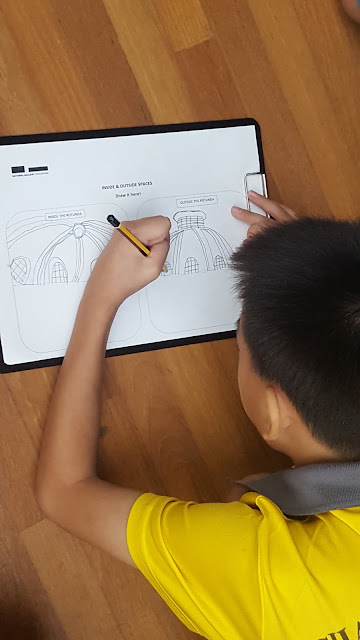When I was a student, my Math tutor, Dr Yeap Ban Har, told us that teachers often tell him that they don't have enough time. He advised us to look at the whole curriculum and be a more effective teacher. For example, in the lower primary Math curriculum, the topic of Time doesn't have to start only when it is time to do so according to the curriculum timeline, we can start at the beginning of the school year by applying in daily situations. I shared this tip with my students' parents on a blog here many years ago.
My English tutor, Dr Babara Spilchuk, was equally inspiring. She taught us similar concept to integrate the arts by making books, writing stories and sharing with each other. The material cost was modest yet kept us, young adults, deeply engaged and hungry for more. One thing that irks her is worksheets. She rejected worksheets, didn't believe in it and so we didn't receive any during her class. We spend a lot of time creating, reading and held discussions in her class.
I grew up consuming worksheets so Dr Spilchuk's class felt more like a visual art class than an English class. After all, my mental schema of an English class was books and worksheets and booklets compiled with photocopied papers.
I guess my tutor was role modelling for us not get too comfortable with a teaching style. She was also showing us that knowledge doesn't exist in isolation. After all, an integrated school curriculum has the potential to alleviate the problems of curriculum overload and fragmentation. As teachers, we can focus on the relationships between subjects to promote learning that applies to several disciplines concurrently and it may allow us to streamline curriculum.
Both my tutors' teaching has somehow urged me to conduct my mini research on integrated learning. The art club pupils have started this project since Term 4 last year. To get a sense of their readiness and their current state of mind about their projects, I conducted a survey. Below is a snapshot of one of the open-ended questions:

Finally, I would like the P3 art club children to experience interacting with this group of game makers so they were given instructions to approach any game maker groups and ask any questions they like. They were given a PQP (Praise, Question, Polish) feedback form to evaluate their chosen game maker group and to provide written feedback after their interaction.
My English tutor, Dr Babara Spilchuk, was equally inspiring. She taught us similar concept to integrate the arts by making books, writing stories and sharing with each other. The material cost was modest yet kept us, young adults, deeply engaged and hungry for more. One thing that irks her is worksheets. She rejected worksheets, didn't believe in it and so we didn't receive any during her class. We spend a lot of time creating, reading and held discussions in her class.
I grew up consuming worksheets so Dr Spilchuk's class felt more like a visual art class than an English class. After all, my mental schema of an English class was books and worksheets and booklets compiled with photocopied papers.
I guess my tutor was role modelling for us not get too comfortable with a teaching style. She was also showing us that knowledge doesn't exist in isolation. After all, an integrated school curriculum has the potential to alleviate the problems of curriculum overload and fragmentation. As teachers, we can focus on the relationships between subjects to promote learning that applies to several disciplines concurrently and it may allow us to streamline curriculum.
Both my tutors' teaching has somehow urged me to conduct my mini research on integrated learning. The art club pupils have started this project since Term 4 last year. To get a sense of their readiness and their current state of mind about their projects, I conducted a survey. Below is a snapshot of one of the open-ended questions:
Next, a collaboration google document with the template below allows all the children to respond to my questions and their friends' comments together. They are also able to read other people's responses that would polish their train of thoughts and written comments. Below is a snapshot of one of the groups' inputs:

Finally, I would like the P3 art club children to experience interacting with this group of game makers so they were given instructions to approach any game maker groups and ask any questions they like. They were given a PQP (Praise, Question, Polish) feedback form to evaluate their chosen game maker group and to provide written feedback after their interaction.

























































